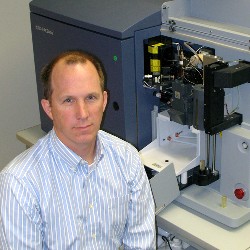Chemical engineers at University of California, Santa Barbara have created molecular probes that the developers say can lead to new drugs to treat cancer and other illnesses. Chemical engineering professor Patrick Daugherty and postdoc Abeer Jabaiah published their findings in a recent online issue of the journal Chemistry & Biology (paid subscription required).
Their work describes a process to build molecular probes to visualize, measure, and learn about the role in tumor metastasis of enzymes called proteases on the surface of cancer cells. “These proteases can enable tumor cells to separate and degrade surrounding tissue, and then migrate to sites distant from the primary tumor,” says Daugherty (pictured right).
The probes allowed the researchers to measure directly the activity of a protease involved in metastasis. They made these observations by adding their probe into a dish of tumor cells, and then measuring the activity of the protease that breaks down collagen, an abundant protein in the human body.
Daugherty and Jabaiah designed one part of the molecular probe to be recognized by a single protease rather than by the many proteases that are present in human tissues. The other part of the probe adds fluorescence to the proteases to measure their activity. They engineered two fluorescent proteins, derived from marine organisms, that absorb and emit light in a process called Forster resonance energy transfer (FRET).
To prepare the probes, the researchers introduced a gene that encodes the probe into E. coli bacteria, known generally as a pathogen, but also used as a test organism in the lab. Then they produced and purified significant quantities of the probe.
All of the information needed for the probe is then encoded by a DNA sequence. The probes are easy and inexpensive to produce, as well as easily shared with other researchers.
Daugherty says they plan to apply this process to human epidermal growth factor receptor 2 (HER2) positive tumors, a biomarker of breast cancer. “A significant fraction of patients have HER2 positive tumors but we don’t know which of those tumors is going to metastasize yet,” says Daugherty. “But our ability to make these probes can allow us to identify which of those HER2 positive tumors have the ability to break down that surrounding tissue, to detach from the primary tumor, and to establish a separate tumor somewhere else in the body.”
Daugherty’s research group has created approximately 25 probes analogous to the one for cancer presented in the paper. They are building a panel of about 100 probes and will use this panel to characterize how different proteases function, which could lead to new drug therapies for a variety of diseases.
Read more: Patent Awarded for Protein Biomarker Cancer Screening
* * *


 RSS - Posts
RSS - Posts
You must be logged in to post a comment.